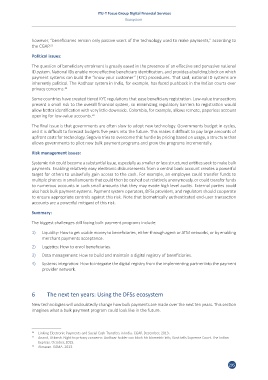Page 323 - The Digital Financial Services (DFS) Ecosystem
P. 323
ITU-T Focus Group Digital Financial Services
Ecosystem
however, “beneficiaries remain only passive users of the technology used to make payments,” according to
the CGAP.
21
Political issues:
The question of beneficiary enrolment is greatly eased in the presence of an effective and pervasive national
ID system. National IDs enable more effective beneficiary identification, and provides a building block on which
payment systems can build the “know your customer” (KYC) procedures. That said, national ID systems are
inherently political. The Aadhaar system in India, for example, has faced pushback in the Indian courts over
privacy concerns. 22
Some countries have created tiered KYC regulations that ease beneficiary registration. Low-value transactions
present a small risk to the overall financial system, so minimizing regulatory barriers to registration would
allow better identification with very little downside. Colombia, for example, allows remote, paperless account
opening for low-value accounts.
23
The final issue is that governments are often slow to adopt new technology. Governments budget in cycles,
and it is difficult to forecast budgets five years into the future. This makes it difficult to pay large amounts of
upfront costs for technology. Segovia tries to overcome this hurdle by pricing based on usage, a structure that
allows governments to pilot new bulk payment programs and grow the programs incrementally.
Risk management issues:
Systemic risk could become a substantial issue, especially as smaller or less structured entities seek to make bulk
payments. Enabling relatively easy electronic disbursements from a central bank account creates a powerful
target for others to unlawfully gain access to the cash. For example, an employee could transfer funds to
multiple phones in small amounts that could then be cashed out relatively anonymously, or could transfer funds
to numerous accounts in such small amounts that they may evade high level audits. External parties could
also hack bulk payment systems. Payment system operators, DFSs providers, and regulators should cooperate
to ensure appropriate controls against this risk. Note that biometrically authenticated end-user transaction
accounts are a powerful mitigant of this risk.
Summary:
The biggest challenges still facing bulk payment programs include:
1) Liquidity: How to get usable money to beneficiaries, either through agent or ATM networks, or by enabling
merchant payments acceptance.
2) Logistics: How to enrol beneficiaries.
3) Data management: How to build and maintain a digital registry of beneficiaries.
4) Systems integration: How to integrate the digital registry from the implementing partner into the payment
provider network.
6 The next ten years: Using the DFSs ecosystem
New technologies will undoubtedly change how bulk payments are made over the next ten years. This section
imagines what a bulk payment program could look like in the future.
21 Linking Electronic Payments and Social Cash Transfers in India. CGAP. December, 2013.
22 Anand, Utkarsh. Right to privacy concerns: Aadhaar holder can block his biometric info, Govt tells Supreme Court. The Indian
Express. October, 2015.
23 Almazan. GSMA. 2013.
295

